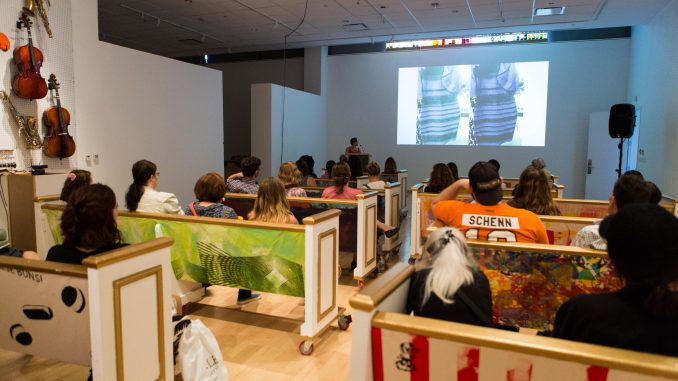
Kory Stamper’s claim to fame is adding the term “F-bomb” into the Merriam-Webster dictionary in 2012.
“It’s a very colorful and evocative word,” she told the Inquirer in 2012. “It’s also a little bit playful in referring to something very serious, someone slipping up and using the F-word where they should not. It has major impact. Usually, major destructive impact.”
Stamper, a lexicographer and an associate editor of Merriam-Webster, visited Temple Contemporary on Monday to give her first talk on defining color in the dictionary.
She said that hunting down a definition of color is anything but black and white.
“[Lexicographers] attempt to describe how certain words are used and what those words mean in particular sentences and contexts,” she said. “This holds even when lexicographers get into the weeds of defining concrete things that get described vaguely.”
To find the definition of a certain color, like blue or black, Stamper and her colleagues have to sort through computerized databases, searching for uses of the word that put it into context.
But context is relative, she said, and the language and culture surrounding the word’s definition can play into how color is perceived. The dictionary definition of color has changed along with advertising campaigns, she added, as she showed slides of 1950s clothing catalogues.
Lexicographers don’t look up color swatches for two reasons, Stamper said. Color is subjective, so what someone says is taupe, a light gray color with hints of tan, for instance, may not be truly taupe. Also, deciding whether or not a certain color is the “right” color is based off one’s perception, which means it isn’t objective enough or lexicography.
When lexicographers run into problematic color definitions, they have to look for technicalities. Stamper said lexicographers will eventually make “cultural assumptions” about how English speakers think of certain words — especially colors — in order to create an easily-understandable definition.
In 2015, when Buzzfeed published a video titled “Black Women Try ‘Nude’ Fashion.” Stamper watched it and was appalled, she said.
After watching the video, in which no Black woman found a “nude” article of clothing or makeup that matched her skin tone, Stamper went to the Merriam-Webster dictionary to find the definition of the word. At the time, Merriam-Webster defined “nude” as “having no clothes on; of or involving people who have no clothes on; having the color of a white person’s skin.”
“The reason why I watched this video is because I was inundated with emails from angry people wanting to know why the hell we thought ‘nude’ meant white people’s skin,” said Stamper, who has been an editor since 1998. “It’s a valid question. The definition was, as I like to say, a giant onion of suck.”
Stamper was only able to convince her colleagues to change the definition of the word once she found eyeshadow palettes that had colors defined as nude, but were much too dark to match a white person’s skin. Over the course of many months and even more revisions, she was able to change the definition to something closer to what the dictionary has today: devoid of a natural or conventional covering; having a color, like pale beige or tan, that matches the wearer’s skin tones.
Yixuan Pan, a 2017 graphic and interactive design MFA alumna, said Stamper’s talk gave her a new perspective on her own art.
“I think it’s another way to think about language,” she said. “It’s something we took for granted, but I think it’s good she’s questioning it and thinking about how it relates to the contemporary world in which we’re living.”
Stamper said she chose to speak about color because defining color is “chasing the visible spectrum of meaning.”
“I think it’s one of the parts of defining that’s kind of squishy,” she added. “Lexicographers like to define things as ‘this is what we do’ and there’s this clear divide between real defining and lexical defining. Even in instances where that line is thin, we can clearly see it.”
“Lexicographers have never dealt with color well, period, and that fascinates me because color is so important to our everyday life,” she added.


Be the first to comment